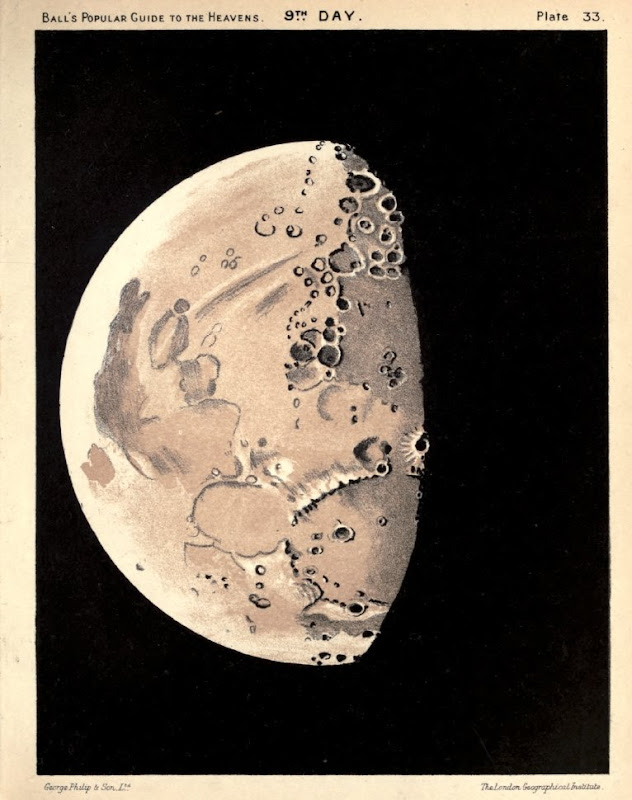Mare Humorum
 Fri 2007-11-09
Fri 2007-11-09 
From The Trouvelot Astronomical Drawings - Atlas, by E. L. Trouvelot, New York, 1882. In the accompanying The Trouvelot Astronomical Drawings - Manual, Trouvelot has this to say about this image:
PLATE VI. MARE HUMORUM.
From a study made in 1875.
A view of one of the lunar plains, or so-called seas (Maria), with an encircling mountainous wall consisting of volcano-like craters in various stages of subsidence and dislocation. The sun-light coming from the west casts strong shadows from all the elevations eastward, and is just rising on the terminator, where the rugged structure of the Moon's surface is best seen. The lighter portions are the more elevated mountainous tracts and crater summits. The detailed description of this Plate given in the body of the MANUAL is repeated here for convenience of reference:
The "Mare Humorum", or sea of moisture, as it is called, which is represented on Plate VI., is one of the smaller gray lunar plains. Its diameter, which is very nearly the same in all directions, is about 270 miles, the total area of this plain being about 50,000 square miles. It is one of the most distinct plains of the Moon, and is easily seen with the naked eye on the left-hand side of the disk. The floor of the plain is, like that of the other gray plains, traversed by several systems of very extended but low hills and ridges, while small craters are disseminated upon its surface. The color of this formation is of a dusky greenish gray along the border, while in the interior it is of a lighter shade, and is of brownish olivaceous tint. This plain, which is surrounded by high clefts and rifts, well illustrates the phenomena of dislocation and subsidence. The double-ringed crater Vitello, whose walls rise from 4,000 to 5,000 feet in height, is seen in the upper left-hand corner of the gray plain. Close to Vitello, at the east, is the large broken ring-plain Lee, and farther east, and a little below, is a similarly broken crater called Doppelmayer. Both of these open craters have mountainous masses and peaks on their floor, which is on a level with that of the Mare Humorum. A little below, and to the left of these objects, is seen a deeply embedded oval crater, whose walls barely rise above the level of the plain. On the right-hand side of the great plain, is a long fault, with a system of fracture running along its border. On this right-hand side, may be seen a part of the line of the terminator, which separates the light from the darkness. Towards the lower righthand corner, is the great ring-plain Gassendi, 55 miles in diameter, with its system of fractures and its central mountains, which rise from 3,000 to 4,000 feet above its floor. This crater slopes southward towards the plain, showing the subsidence to which it has been submitted. While the northern portion of the wall of this crater rises to 10,000 feet, that on the plain is only 500 feet high, and is even wholly demolished at one place where the floor of the crater is in direct communication with the plain. In the lower part of the mare, and a little to the west of the middle line, is found the crater Agatharchides, which shows below its north wall the marks of rills impressed by a flood of lava, which once issued from the side of the crater. On the left-hand side of the plain, is seen the half demolished crater Hippalus, resembling a large bay, which has its interior strewn with peaks and mountains. On this same side can be seen one of the most important systems of clefts and fractures visible on the Moon, these clefts varying in length from 150 to 200 miles.
More of Trouvelot's astronomical drawings can be found here.



